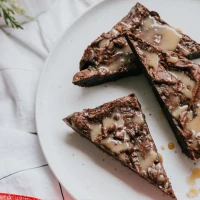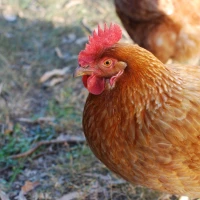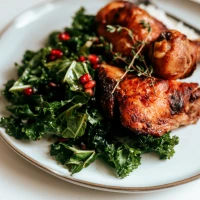When it comes to a fail-safe dinner option that’s both satisfying and easy to prepare, baked chicken thighs undoubtedly take the prize. However, not all chicken thigh dishes are created equal. To achieve that sublime balance of crispy skin and tender, juicy meat, there’s a particular temperature that works like magic: 350°F. Combine this with the right vegetables, and you can enhance the flavor and add a healthful twist to your meal. In this comprehensive guide, we’ll lead you through the secrets of achieving the ultimate vegetable-rich baked chicken thighs, ensuring every bite is a mouthful of perfection. So preheat your ovens and get ready to master a culinary classic that will impress taste buds time and again.
In our journey to unlock the secrets of baked chicken thighs how long at 350, we’ll delve into everything from seasoning to the importance of resting your meat. With our expert tips and mouthwatering vegetable pairings, this dish could soon become your go-to for an easy, delicious dinner.
Seasoning and Marinades: Enhancing Flavor Before Baking
To begin, let’s talk about the first step to incredible baked chicken thighs - the seasoning. Sure, salt and pepper can do the trick, but why settle for basic when you can have extraordinary? Here’s how to amp up the flavor:
- Create a Marinade: Whether it’s a simple mixture of olive oil, lemon juice, garlic, and herbs or something more exotic, marinating your chicken thighs can ensure every bite is infused with flavor.
- Dry Rubs: Combine spices like smoked paprika, onion powder, and a touch of brown sugar for a sweet and smoky crust that will make your taste buds dance.
- Fresh Herbs: Sprigs of rosemary, thyme, or oregano tucked beneath the skin can gently perfume the meat as it bakes.
The Right Vegetables to Accompany Your Chicken
Fusing vegetables into your baked chicken dish isn’t just about nutrition; it’s about flavor synergy. Here are some top veggies to consider:
- Carrots: Their natural sweetness complements the savoriness of the chicken.
- Potatoes: Choose from sweet or regular, and enjoy the comforting, hearty addition.
- Brussels Sprouts: These little cabbages caramelize beautifully and offer a nutty contrast.
Preparing the Chicken and Vegetables for Baking
Cleaning and Prepping Chicken Thighs
Before any spices touch your chicken, make sure that you’re starting with a clean slate:
- Pat the Chicken Dry: Remove any excess moisture with paper towels. Dry skin means crispier results.
- Trim the Fat: While some fat is necessary for flavor and moisture, too much can lead to greasiness.
Cutting and Seasoning Vegetables
For your vegetables to cook evenly alongside your chicken thighs, follow these steps:
- Cut all veggies to a similar size for uniform cooking.
- Toss them in a bit of oil and season well to match the chicken’s flavor profile.
The 350°F Oven: A Slow Roast to Perfection
Now, let’s zero in on the temperature. Cooking your chicken thighs at 350°F might seem standard, but it’s actually the key to achieving perfection. It allows for a slow roast, which tenderizes the meat and gives the skin enough time to crisp up without burning.
Baking Chicken Thighs: Timing and Techniques
Understanding how long to bake chicken thighs at 350°F is crucial. Here’s what you need to know:
- Bone-in, skin-on thighs generally require about 40-50 minutes.
- Boneless, skinless thighs may only need 20-30 minutes.
Always use a meat thermometer to ensure the internal temperature has reached 165°F for safe consumption.
Exploring the Maillard Reaction: Why Baked Chicken Gets Crispy
Understand that it’s not just heat that’s giving your chicken thighs that crave-able crispy skin - it’s science. The Maillard reaction, a chemical process that occurs during cooking, is what provides that golden-brown deliciousness. And at 350°F, this reaction happens at just the right pace.
Avoiding Soggy Skin
To prevent sogginess and guarantee that perfectly baked chicken skin:
- Do not cover the chicken while it’s baking.
- If you’re using a sauce, apply it in the last few minutes of cooking to avoid creating steam.
Vegetable Pairings and Side Dishes
A great chicken dish isn’t complete without the perfect sides. Here are some vegetable side dishes that go wonderfully with baked chicken thighs:
- Roasted Asparagus: Quick, simple, and elegant.
- Sautéed Green Beans: Lively and fresh with a hint of garlic.
- Creamed Spinach: Decadently balanced against the robust flavors of chicken.
Creating a Complete Meal with Starches and Vegetables
While baked chicken thighs at 350°F are mouthwatering, they are even better when served with starches that capture the chicken’s juices and vegetables that can roast in the same pan, absorbing all the delicious flavors.
One-Pan Wonders: The Perfect One-Dish Meal
Imagine your chicken and veggies cooking together in harmony, each component soaking up the flavors of the other. Here’s how:
- Arrange seasoned veggies around your chicken thighs in a large baking dish.
- As they cook, baste the thighs and veggies occasionally with the pan juices.
- You’ll end up with a symphony of flavors, all in a single pan for easy cleanup.
How to Store and Reheat Leftovers
Leftover baked chicken thighs are gold, and storing them correctly means you can enjoy the meal again. Cool them quickly and refrigerate within two hours of cooking. When reheating, bring them back up to at least 165°F to ensure they’re hot and tasty.
The Art of Presentation: Serving Baked Chicken Thighs
Tips for Plating Like a Pro
Boldly place your chicken thigh on the plate, showcasing that beautifully baked skin. Arrange your roasted vegetables and starches around the chicken in an inviting way, and garnish with a sprig of fresh herbs for that restaurant-quality look.
Conclusion: Baked Chicken Thighs, the 350°F Way
Baking chicken thighs at a precise 350°F is not just a cooking method; it’s an art form. By focusing on seasoning, the right vegetable pairings, and the perfect oven temperature, you’re setting yourself up for success. So grab those thighs and veg, preheat your oven, and get ready to enjoy a delicious, nutritious meal that’s sure to become a staple in your kitchen.
Remember: patience is key. Give your chicken the full time it needs in the oven, and let it rest before serving. You’ll be rewarded with perfectly baked chicken thighs that are equal parts juicy, flavorful, and simply irresistible.










